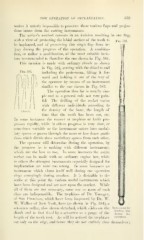Page 661 - My FlipBook
P. 661
THE OPERATION OF IMPLANTATION. 659
makes it utterly impossible to preserve these various flaps and projec-
tions intact from the cutting instruments.
The writer's method consists in an incision resulting in one flap,
with a view of protecting the labial surface of the tooth to
Ym. 583.
be implanted, and of preserving this single flap from in-
jury during the progress of the operation. A combina-
tion, or rather a modification, of the most suitable incis-
ions recommended is therefore the one shown in Fig. 581.
This incision is made with ordinary chisels as shown
in Fig. 582, cutting with the chisel to and
including the periosteum, lifting it for-
1 \ m\ r \ ward and holding it out of the way of
the operator by means of an instrument
similar to the one shown in Fig. 583.
The operation thus far is usually sim-
ple and as a general rule not very pain-
ful. The drilling of the socket varies
with diiferent individuals according to
^^^^ density of the bone, the length of
Chisels
time that the tooth has been out, etc.
In some instances the reamer or trephine or knife pro-
gresses rapidly, while in others progress is very slow, or
sometimes variable as the instrument enters into medul-
lary spaces or passes through the more or less dense parti-
tions which divide these medullary spaces from each other.
The operator will determine during the operation, by
the progress he is making with different instruments,
which are the best to use. In some instances the entire
socket can be made M'ith an ordinary engine bur, while
in others the strongest instruments especially designed for
implantation are none too strong. In some instances an
instrument which clears itself well during one operation
clogs annoyingly during another. It is desirable to de-
scribe at this point the various useful instruments which
have been designed and are now upon the market. While
all of them are not necessary, some one or more of each
class are indispensable. The trephines of Dr. Younger,
of San Francisco, which have been improved by Dr. W.
W. Walker of New York, have (as shown in Fig. 584), a
set-screw collar, also shown detached, which slides on the Instrument for
holding flap
shank and is first fixed by a set-screw as a gauge of the
during the
length of the tooth root. As will be noticed the trephines operation.
cut only on the edge, and hence they do not entirely clear themselves
;,


